NascoBLOG 14
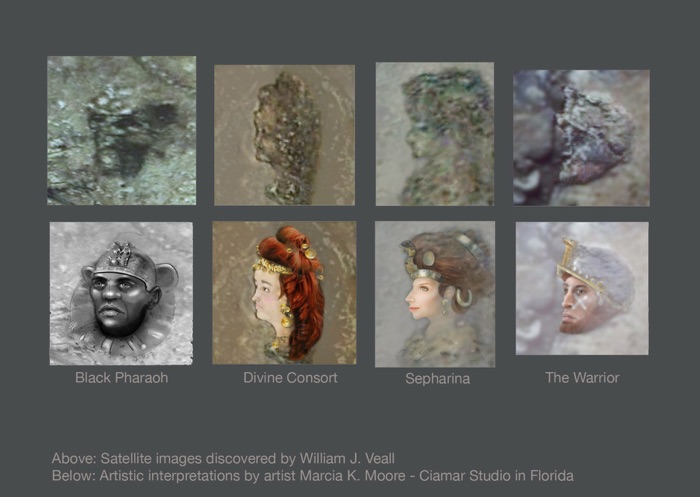
(c) William James Veall
"Portraits of the Gods": William J.Veall interviewed on Earth Ancients Interviewer Cliff Dunning
Listen to the fascinating Audio interview between Cliff Dunning, Host of Earth Ancients and English Archaeoastronomer, William James Veall, broadcast on Blogtalkradio.com, 27th September 2014.
An interview which, according to the Host, Mr Cliff Dunning,1st Oct 2014 and I quote:
William,
'Your interview on Earth Ancients is fast becoming the most popular that I've encountered'.
...'there has, to date, been over one thousand downloads of the audio programme, in just a few days, (a record).'
'Lets keep the option open for a future programme'.
And again on the1st October 2014 Mr Cliff Dunning wrote:
'Portraits of the Gods' is now the Number One, Alternative News Programme for the week on Blogtalkradio.com. They have 20 million listeners each month, so a number one spot is a significant achievement.
Cliff Dunning.
General: Cliff Dunning questions many aspects of my early research into Peru's pre-Columbian cultures and how my investigations eventuallly led to the discovery of the quite unique and rare imagery depicted in my new book "Portraits of the Gods".
Cliff pressed me to tell the listeners a little of the background of how I also came to make the momentous exposure of no less than five completely unknown archaeological sites on the High Altiplano of Southern Peru's, Andean Mountain chain, again, as described in "Portraits of the Gods". Not counting, the unbelievable discovery of a massive 3rd to 4th century, BC, Phoenician inscription actually imprinted within the Nasca Lines.
Below are some of the topics discussed during the interview:
---- In the beginning
---- Southern Evening Echo (UK) interview
---- Exploratory visit to Lima, Peru
---- The Nasca Lines and Phoenician inscription
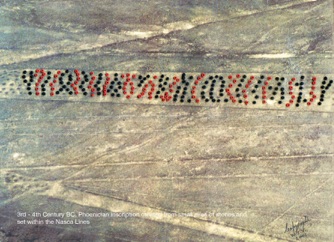
---- Advances made after using Remote Sensing Satellite technology
---- "The Temple of the Sacred Lamb"

---- Discovery of the "Plaza of the Gods"
---- Discovery of the "Scriptorium"
---- The link between the "Linear Observatory" and the "Planetarium"
---- Peer reviews available ? Question from Mexico
---- Funding Stage Two of the Project. How?
Please now log on to the link below and listen to the fascinating audio that broke Earth Ancients, audience record; then went on to become Number One, Alternative News Programme of the week on Blogtalkradio.com with over 20 million listeners each month - a significant achievement for "Portraits of the Gods".
https://www.blogtalkradio.com/earthancients/2014/09/27/william-veall-portraits-of-the-Gods
Finally, I have added the link to an earlier video of the "Temple of the Sacred Lamb" shot in continuous sequence to authenticate not only the actual High Andes location but the setting of the actual "Temple" sculptures referred to in the Earth Ancients podcast.
http://vimeo.com/85080058 (Temple of the Sacred Lamb by Nascodex Publications)
Don't forget you can still order copies of "Portraits of the Gods " immediately by clicking on to the Button below.
ORDER BUTTON.
William James Veall
NascoBLOG 13
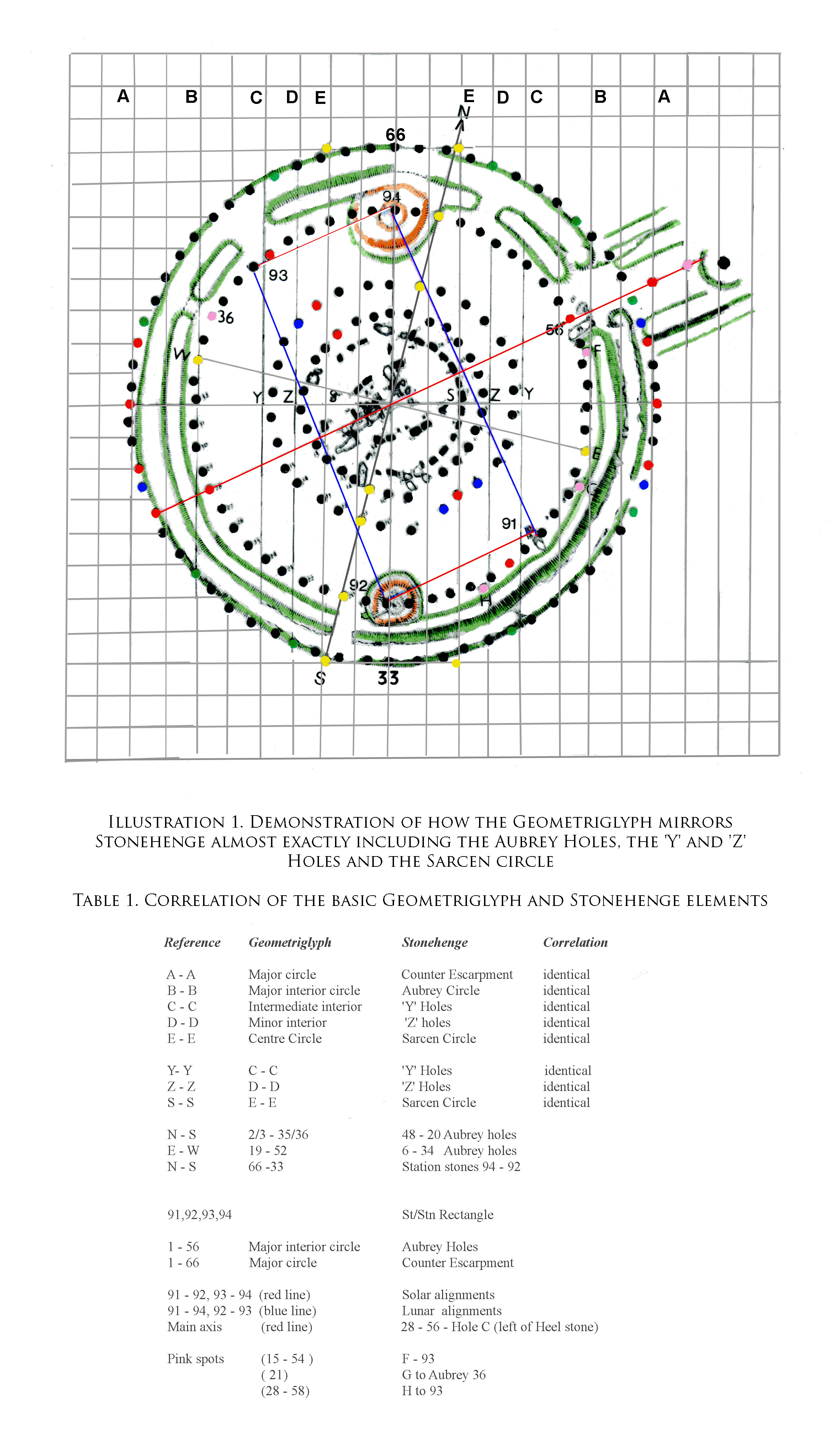
c) William James Veall
Hello and Welcome to NascoBlog13, March 2014.
We left NascoBlog12 last January in the middle of the discussion "Just how old is the 'Geometriglyph'? We had arrived at a date between 1100 BC and 800 BC but then some comparative research showed a strange anomaly; alignment of a Geometrigyph template over the ground plan of the famous Stonehenge Monument, in the UK, threw up some quite remarkable coincidences.
When the Summer Solstice Sunrise azimuthal, i.e the alignment running due N.E from the Geometriglyph's centre point - was superimposed over the same on a ground plan of the Stonehenge Monument, one could not help but notice a number of intriguing coincidences which you can see deliniated on Illustration 1 and Table 1, above.
Notice how the N - S meridian of the Geometriglyph (Stations 66 - 33) conjoins exactly Station Stone 94 to the opposite Station Stone 92; the alignment also being a diagonal of the Stonehenge Station Stone Rectangle. Respective N/S meridians were approxiamately 13.5º apart.
This is how I discovered that the Geometriglyph cannily mirrors the 'Station Stone Rectangle' where the solsticial sun and maximum moon extremes align at an (almost) exact right angle - the only place in the world where such a unique phenomenum occurs. How on earth did the Old World architects of the Geometriglyph calculate this event occurs only at the exact latitude and longtitude of a place on the map that we in the modern world call 'Stonehenge'. Why was this remote spot, so far away in the New World, special to an ancient civilisation?
It is important to understand that the Station Stones Rectangle will only perform within one half of a degree north or south of the latitude of Stonehenge. Any place else in the World the rectangle becomes a parallelogram; this is what makes its unique placement so mysteriously intriguing. One can readily accept an astronomical reason, but what was the real purpose behind this 'on the spot' meeting of the sun and moon?
Above, I have printed out for you a copy of Illustration 1: Stonehenge overlaid with the basic Geometriglyph's elements which you can see coincide almost exactly to leave one in no doubt that the two are one and the same. To make life easy, I have added Table 1 of the essential coincidentals.
Here I must emphasise that I am not saying that Egyptians, Phoenicians or even the ancient Greeks actually 'constructed' this stone henge. To the best of my knowledge there is nothing in the archaeological record that supports a massive 'Old World' led enterprise. What I am setting out to prove is a form of metrology based upon pure geometrics and a universal unit of measurement, spread on an international scale from at least 4000 BC and it was this (stone circle) design facility that was subsequently 'imported' into an Early Neolithic - Bronze Age, Britain. More about this in NascoBlog14.
Let us pause for a moment to complete answering the topic question - the age of the Geometrigylph? Its almost unquestionable relationships with Megalithic structures down through the Ages from the time of the Pyramids of ancient Egypt (even the slope length of the Great Pyramid of Giza and the radius of the Geometriglyph are inter-related) to Stonehenge (2800 BC), suggests a life span circa 4000 BC unto, perhaps, the final elaboration of the Nasca/Palpa Geoglyphs which had almost certainly drawn to a close by AD 690 due to extensive desertification ("Portraits of the Gods" Nascodex Publications 2010). A time scale stretching back some 5000 years.
Interactive question: Now here is your interactive question: Bearing in mind the date of Stonehenge Phase1 (circa 2800 BC) and the arrival of 'overseas' Traders for gold and tin to south west Britain; Do you think this had any influence on the choice of location for the Stonehenge Monument. If so, what?
Next month's NascoBlog14 will examine more relationships between the Geometriglyph, Stonehenge and other major stone circles of the UK in an attempt to answer the question," So, just who did build Stonehenge"?
Till we meet again, All Best Wishes and I look forward to some interesting answers to the interactive question.
There is still time to ORDER your copy of "Portraits of the Gods". Please Click the ORDER BUTTON.
William James Veall
NascoBLOG 12
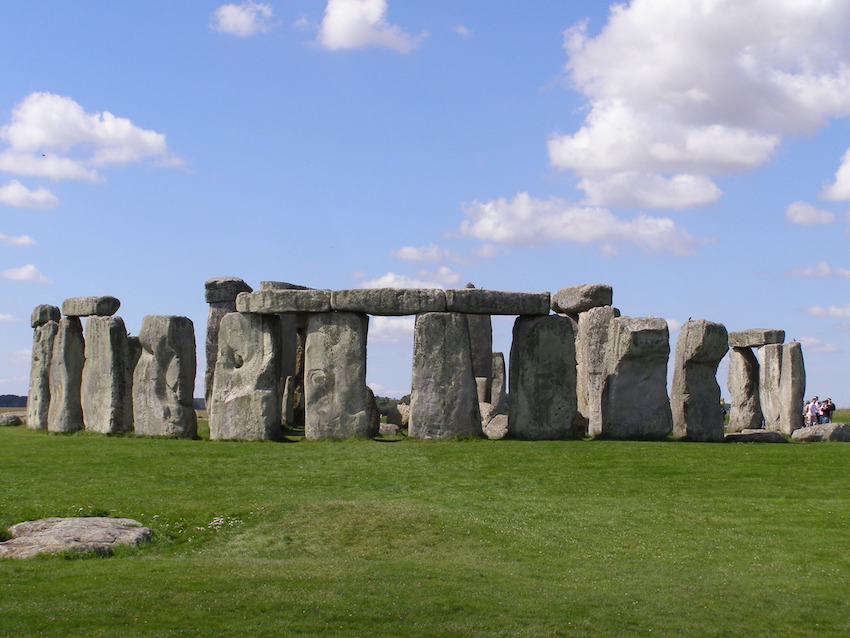
Author: garethwiscombe Source
GREETINGS AND A VERY HAPPY NEW YEAR 2014 TO YOU ALL
NascoBlog12 is my first of the New Year 2014 and continues with more exciting news about the capabilities of the 'Geometriglyph'.
Remember last year I explained that this fascinating device had a built in facility whereby linear measurement could be used to calculate the volume of solids or liquids. Yes, you read it correctly - using a tape measure to determine the liquid content (wine?) of a vessel. Solids are easy because we can measure (a box) linearly and simply multiply to obtain the internal volume.
I have been asked a number of times since, how a tape measure could possibly indicate the volume of liquid in a vessel ? So, here is a short explanation minus mathematics.
So firstly, have quick look again at the Geometriglyph diagram in NascoBlog10. Here you see both rectangular and circular shapes set within a rectilinear compartmental grid. The' inventors' used the edges of the rectangle as linear units and then integrated the spherical (circumferencial) units; the resulting 'Celestial Constant' (5.4545) was the common, universal factor which could be employed to express both units of length as well as volumetric capacity.
NOTE: Anyone interested in studying this subject further, I recommend the excellent research report : PLOS one. An Ancient Relationship between Units of Length and Volume Based on a Sphere. (Zapassky, Gadot, Finkelstein and Benenson. March 28th 2012. Available on-line)
NOTE: Not wishing to be accused of plagerism, I would like to make it clear that whilst I extrapolated the single unit, linear/spherical relationship back in 2002, the above Report considerably strengthend the evidence I had previously uncovered that Greco-Phoenicians may have used a common measuring unit to survey and construct the Nasca Lines..
Another question came up recently: So, just how old is the 'Geometriglyph' since you throw open the statement that the device, seemingly, has roots going back to the ancient Minoan Civilisation, 2700 B.C. - 1500 B.C.?
A very interesting question which I cannot answer fully in a relatively short NascoBlog, however, I promise all of the relevant evidence will be put in front of Readers in the follow-on series of NascoBlogs. So briefly...
a) The Geometriglyph is located on a rocky hillside overlooking the Nasca Lines. Most historians now agree the geoglyphs were possibly in an advanced state of elaboration, circa 800 B.C. There is nothing to suggest that the 'Mandala' is not part of the the Nasca Lines.
b) My research confirms the Nasca geoglyphs were constructed according to astronomical phenomena. The Geometriglyph mirrors this astronomical/geoglyphic relationship, thus the device must also date circa 800 B.C. I believe the Geometriglyph was 'constructed' at its location as a vital surveying tool, not 'invented' on-the-spot for the purpose in hand.
c) The device also mirrors the celestial targets hypothesised for both the Linear Observatory and the vast Landscape Planetarium in the Southern Andes Mountains. (Portraits of the Gods, Nascodex Publications. 2010) The presence of Phoenician inscriptional material at each of these sites allows one to extend the predictive hypothesis to a date between 1100 B.C. (earliest known date for the Phoenician alphabet) and 800 B.C.
However, at this juncture we run into a major anomaly:
d) When I made a comparison between the Geometriglyph and an official ground plan of Stonehenge, not only was there the usual strong correspondence between solar and lunar phenomena but something truly amazing occurred; aligment of the summer solstice sunrise azimuthal exposed Stonehenge's infamous 'Station Stone Rectangle' clearly deliniated within the Geometriglyph's matrix.
Tempted to go a stage further, I found an almost exact coincidence between the 'stone circles' within the Geometriglyph to those within Stonehenge, for example, the Aubrey holes, the 'X' and 'Y' holes and even the Sarcen circle. Next month's NascoBlog13 will include a diagrammatic representation of this remarkable new find and how it was hiding a template of the Great Pyramid of Giza.
Can then the Geometriglyph really be as old as the Pyramids and Stonehenge, 2800 B.C. and beyond? We know for certain who built the Pyramids of Egypt but did these people also design and then help to build Stonehenge, and more important, Why?
Meantime, Good Luck and Very Best Wishes to You All.
There is still time to ORDER your copy of "Portraits of the Gods". Please Click the ORDER BUTTON.
William James Veall
NascoBLOG 11
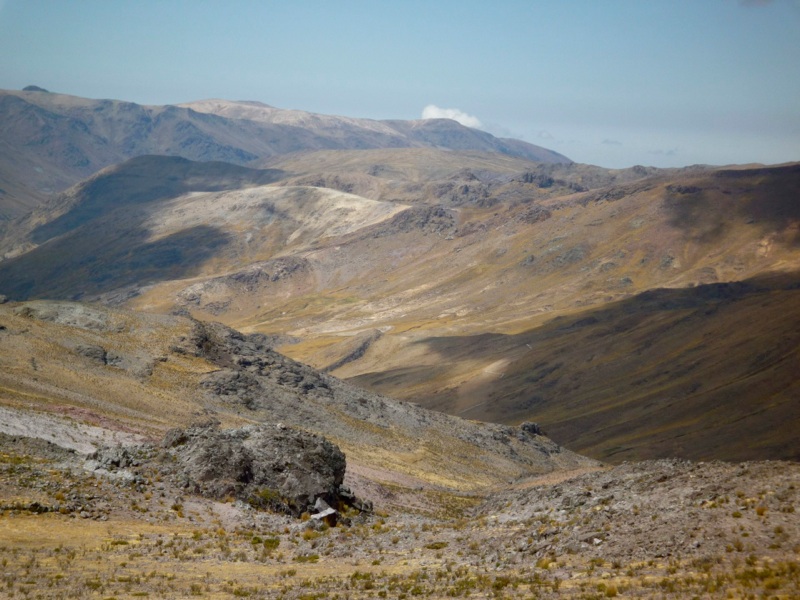
Image (c) WILLIAM JAMES VEALL
Greetings to you all. Welcome to NascoBlog11.
Firstly, a note of apology. Due to a computer glltch after installing new software, it has been necessary to remove the originals and reissue NascoBlogs 10 and 11.
So, to continue from NascoBlog10 The 'Geometriglyph' may have not only been designed for archaeoastronomical surveying but the inherent 'Celestial Constant' (5.4545) appears to allow it to express linear lengths in terms of a 'Universal Unit of Measurement'. For example, convert an ancient linear measurement into a metric equivalent, divide by the celestial constant, the result will be expressed as an almost exact 'Phoenician' 'Universal Unit'.
It is therefore a small step to create a standardised linear measuring rod or flexible 'tape measure'. Well, it turns out that the Egyptians, for example, calculated the volume of liquid in standard rounded vessels (wine) by measuring the major circumference. So, now we have the Geometriglyph measuring volumes!
https://english.tau.ac.il/news/measuring_system
In my humble opinion, forget about 'elbow to thumb', 'size of the King's left foot' or any of the other weird notions concerning the world's invention of units of measurement. Advanced, sophisticated societies would not have tolerated such a plethora of juxtaposed systems of measurement ("The King is Dead. Long live the King - with his larger/smaller left foot !!”). Units would have to be to a precise linear, spherical or volumetric standard of measurement.
The one great universal constant the world over is the Heavens. Eternal ancestral home, ever changing, but never changing. Constant through all eternity. Units created from the Heavens transmuted for use on earth.
To learn more about this remarkable device log on to:
http://www.nascodex.org/NX/Geometriglyph.html
The "Lost island of Atlantis": To recap, in NascoBlog9 we put all the evidence in place to prove that "Atlanteans" from the Mediterranean journeyed to, and took up residence, in the Andean Highlands of Peru and created a "Kingdom of the Dead" and "Highway of the Dead".
I will now put in place the last piece of the puzzle to one of the World's great mysteries: If my foregoing hypothesis about Atlantis was true: I had to prove those self-same Peoples from the Mediterranean carved the mass of inscriptive material and multi-racial human head figurals and not the indigenous Indians.
The indigenous population at the time were basically illiterate having no form of known written communication whatsoever between themselves, let alone produce hundreds of inscriptions using 'Phoenician' characters. I doubt very much they could have compiled the vast Scriptorium which is entirely enscribed in Phoenician.
Further, the human busts exhibit no trace of indigenous Indian physiognomy; they are classic Greco-Roman, Arabic or Syrian, Chinese or Hindu. Others have the appearances of being not Negroid but Black-African.
Finally, neither the Nasca Culture nor any other of the indigenous tribes, had - or indeed exhibited - the scientific or mathematical knowledge to construct sophisticated archaeological monuments like the Nasca LInes, the huge Landscape Planetarium or the Southern Andes Linear Observatory. Nor to cartographically plan and execute a 300 kilometre "Great Highway".
(See Portraits of the Gods. Nascodex Publications 2010).
Thus, from the foregoing evidence and its early chronology, it is clear Peoples from the Old World Civilisations MUST have brought this knowledge into Peru and among those Peoples the main protagonists were the Phoenician - Canaanites from the Lebanon who eventually remained in residence for nearly 800 years.
NascoBlog11 is the final NascoBlog for 2013. I hope sincerely that you have enjoyed travelling along one archaeoastronomers' road of discovery. For me it has been an incredibly, intensive, but exciting and, may I say modestly, successful Year 2013 culminating in the discovery which suggested the 'Continental Island' of South America was indeed the 'Long Lost Island of Atlantis'.
Further, the long held, much venerated belief that Columbus discovered America was blown completely out of the water (s'cuse the pun) by massive evidence from the Phoenician's 'New World Kingdom' ("Portraits of the Gods". Nascodex Publications. 2010) which they, and their multi-racial counterparts, occupied in the Southern Andes of Peru for 800 years, or more. Thus, I was able to confirm the long held Diffusionist's belief that Trans-Oceanic Peoples from the Mediterranean were the first to set foot in the Americas, 3000 years BEFORE Christopher Columbus.
I am very hopeful that in the coming New Year a transliteration of some of the inscriptive material discovered will devolve a new name for us to celebrate as the true discoverer of America and in turn put their country of origin into the history books - or until the next time - an archaeologists' trowel or passing satellite pauses in a new act of discovery.
A VERY HAPPY CHRISTMAS AND PEACEFUL NEW YEAR 2014 TO YOU ALL
There is still time to ORDER your copy of "Portraits of the Gods" in time for Christmas, please Click the ORDER BUTTON.
William James Veall
NascoBLOG 10
Image (c) WILLIAM JAMES VEALL
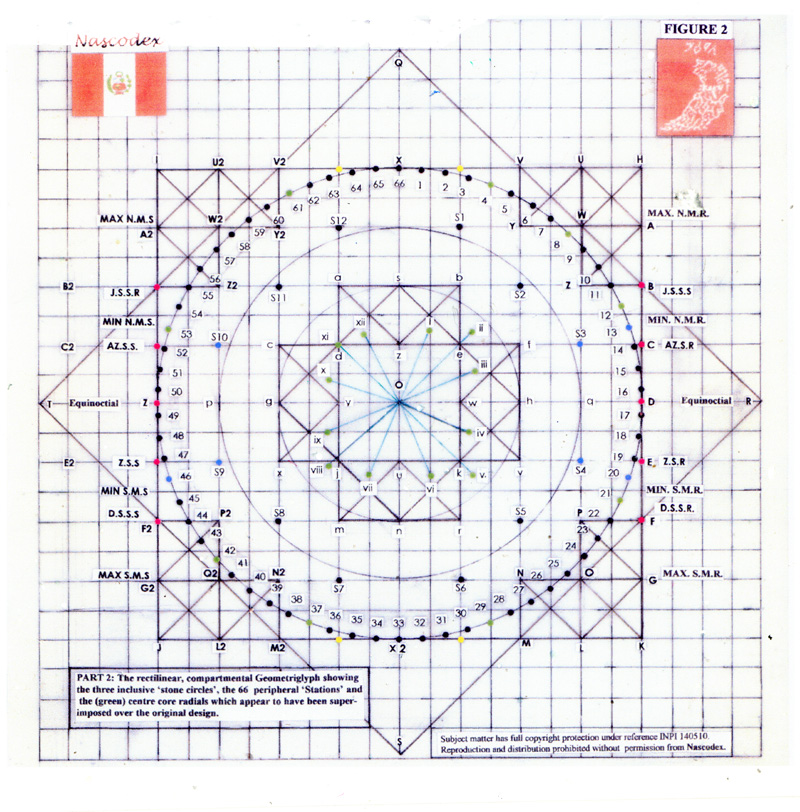
Hello and welcome to this re-issue of NascoBlog10. 13th November 2013.
Firstly a note of apology: Owing to a computer glitch after installing new software, it is necessary to reissue this NascoBlog10. Para 9 and 10 contained co-ordinate errors and has been removed for correction. The item will be carried over to a NascoBlog in the New Year.
Back to the topic. Last week I introduced a rather special Figural in the foothills of the Nasca Pampa called a 'Mandala' and how I had analysed and tested this geometrical geoglyph and found it was importantly associated with the 'Lines' and as such helped to prove they were constructed in accordance with astronomical phenomena.
The first stage in constructing my 'Mandala' - which I call a 'Geometriglyph' - was to reproduce an acccurate copy of the figural from an aerial photograph which presented a measure of difficulty because the geoglyph is sited on a sloping, irregular, rock- face.
For your interaction this week: log-on to Google Earth, enter the co-ordinates Latitude 14 38 38S. Longtitude 75 10 16W to view and explore the 'Mandala' for yourself. Notice its closeness to the Nasca Lines Display opposite.
I have not included in NascoBlog10 the intricate geometry or astronomy behind the construction of the 'Geometriglyph' so have kept the text purely descriptive. Firstly, note that the rectilinear, compartmental Geometriglyph comprises of two rectangles, rotated 90º to each other. There are three stone circles, an inner core circle which contains a number of small radials, an intermediate circle and a large outer circle. The sides of the core rectangle are set tangential to the outer circle. Ignore for now the inner circles, radials, grid lines and corner compartments.
For the moment we will concentrate on the Geometriglyph's outer circle because it has a most unusual feature. The circle is divided by 66 stone markers. Sixty six seems at first glance to not only be an observational error on my part, but a quite inconvenient rather random number. Each numbered circumferencial division is equal to 5.4545 º; this number, which I call the 'Celestial Constant', has proven to be truly unique. (I will explain in NascoBlog11)
(The Minoan Civilisation, 2700BC - 1500BC (Bronze Age)) allegedly produced a disc shaped bronze calendar which automatically corrected the imbalance between the calendar year (365 days) and a solar (seasonal) year of 365.2422 days. Unfortunately, no record exists as to how the disc automatically intercalated the extra day every fourth (leap) year.
(Butler, A. 'A Bronze Age Computer Disc’. Quantum. Mar. 1999).
However, to continue. I decided to stick with the '66' anomaly and project diagonals through the Geometriglyph's centre point. Hey presto! The figural recorded solstices, equinoxes, the zeniths and anti-zeniths and lunar maxima and minima cycles. Also certain first magnitude stars, and even the beautiful Pleiades constellation.
I cross -checked the Geometriglyph over many Nasca Lines' features: long and short geoglyphic lines, zig-zags (proving in the process that they could/were used as Linear Observatories), trapezoidal, triangular and rectangular areas, Line centres (after Aveni), ceques (after Zuidema) and many of the well known figurals, the Monkey, Killer Whale, Hummingbird, the Snakebird (Cormorant) and the Spider, to name just a few.
Apart from my Nasca Lines research; this remarkable astronomically constructed device was utilised during my research and subsequent discovery of the Southern Andes Linear Observatory and the vast Landscape Planetarium, 4.500 metres above sea level, in the Peruvian Andes Mountains.
"Portraits of the Gods". Nascodex Publications. (Click below to Order)
In truth, the device is so versatile I have used it to analyse pyramids, tombs and temples, and many stone circles like Stonehenge and Avebury in the UK along with other edifices across the archaeological world. As a guide for architecture suspected of being constructed in accordance with celestial phenomena the Geometriglyph has proved invaluable. It was this 'international' feature which strengthened my convictions that the Nasca Culture did not construct the basic Nasca Lines.
Note: The Geometriglyph has full International Copyright Protection under Registration Code INPI 140510 and must not be reproduced by any means whatsoever without written permission from Nascodex or the author, William James Veall.
In NascoBlog11 you will learn how the 'Celestial Constant' formed basic 'Units of Measurement' for transposing on to linear rods or 'tape measures' and how it may have been used for calculating the volume of liquid (wine) in a vessel:
https://english.tau.ac.il/news/measuring_system
I will tell you more about this exciting discovery in NascoBlog11 on the 28th November 2013. and, as promised, how it weaves together my hypothesis that South America is the true "Long Lost Island of Atlantis".
Be with you all again on 28th November 2013.
Your copy of "Portraits of the Gods" can be easily obtained by Clicking the ORDER BUTTON . Thank you.
William James Veall

Hello and welcome to this re-issue of NascoBlog10. 13th November 2013.
Firstly a note of apology: Owing to a computer glitch after installing new software, it is necessary to reissue this NascoBlog10. Para 9 and 10 contained co-ordinate errors and has been removed for correction. The item will be carried over to a NascoBlog in the New Year.
Back to the topic. Last week I introduced a rather special Figural in the foothills of the Nasca Pampa called a 'Mandala' and how I had analysed and tested this geometrical geoglyph and found it was importantly associated with the 'Lines' and as such helped to prove they were constructed in accordance with astronomical phenomena.
The first stage in constructing my 'Mandala' - which I call a 'Geometriglyph' - was to reproduce an acccurate copy of the figural from an aerial photograph which presented a measure of difficulty because the geoglyph is sited on a sloping, irregular, rock- face.
For your interaction this week: log-on to Google Earth, enter the co-ordinates Latitude 14 38 38S. Longtitude 75 10 16W to view and explore the 'Mandala' for yourself. Notice its closeness to the Nasca Lines Display opposite.
I have not included in NascoBlog10 the intricate geometry or astronomy behind the construction of the 'Geometriglyph' so have kept the text purely descriptive. Firstly, note that the rectilinear, compartmental Geometriglyph comprises of two rectangles, rotated 90º to each other. There are three stone circles, an inner core circle which contains a number of small radials, an intermediate circle and a large outer circle. The sides of the core rectangle are set tangential to the outer circle. Ignore for now the inner circles, radials, grid lines and corner compartments.
For the moment we will concentrate on the Geometriglyph's outer circle because it has a most unusual feature. The circle is divided by 66 stone markers. Sixty six seems at first glance to not only be an observational error on my part, but a quite inconvenient rather random number. Each numbered circumferencial division is equal to 5.4545 º; this number, which I call the 'Celestial Constant', has proven to be truly unique. (I will explain in NascoBlog11)
(The Minoan Civilisation, 2700BC - 1500BC (Bronze Age)) allegedly produced a disc shaped bronze calendar which automatically corrected the imbalance between the calendar year (365 days) and a solar (seasonal) year of 365.2422 days. Unfortunately, no record exists as to how the disc automatically intercalated the extra day every fourth (leap) year.
(Butler, A. 'A Bronze Age Computer Disc’. Quantum. Mar. 1999).
However, to continue. I decided to stick with the '66' anomaly and project diagonals through the Geometriglyph's centre point. Hey presto! The figural recorded solstices, equinoxes, the zeniths and anti-zeniths and lunar maxima and minima cycles. Also certain first magnitude stars, and even the beautiful Pleiades constellation.
I cross -checked the Geometriglyph over many Nasca Lines' features: long and short geoglyphic lines, zig-zags (proving in the process that they could/were used as Linear Observatories), trapezoidal, triangular and rectangular areas, Line centres (after Aveni), ceques (after Zuidema) and many of the well known figurals, the Monkey, Killer Whale, Hummingbird, the Snakebird (Cormorant) and the Spider, to name just a few.
Apart from my Nasca Lines research; this remarkable astronomically constructed device was utilised during my research and subsequent discovery of the Southern Andes Linear Observatory and the vast Landscape Planetarium, 4.500 metres above sea level, in the Peruvian Andes Mountains.
"Portraits of the Gods". Nascodex Publications. (Click below to Order)
In truth, the device is so versatile I have used it to analyse pyramids, tombs and temples, and many stone circles like Stonehenge and Avebury in the UK along with other edifices across the archaeological world. As a guide for architecture suspected of being constructed in accordance with celestial phenomena the Geometriglyph has proved invaluable. It was this 'international' feature which strengthened my convictions that the Nasca Culture did not construct the basic Nasca Lines.
Note: The Geometriglyph has full International Copyright Protection under Registration Code INPI 140510 and must not be reproduced by any means whatsoever without written permission from Nascodex or the author, William James Veall.
In NascoBlog11 you will learn how the 'Celestial Constant' formed basic 'Units of Measurement' for transposing on to linear rods or 'tape measures' and how it may have been used for calculating the volume of liquid (wine) in a vessel:
https://english.tau.ac.il/news/measuring_system
I will tell you more about this exciting discovery in NascoBlog11 on the 28th November 2013. and, as promised, how it weaves together my hypothesis that South America is the true "Long Lost Island of Atlantis".
Be with you all again on 28th November 2013.
Your copy of "Portraits of the Gods" can be easily obtained by Clicking the ORDER BUTTON . Thank you.
William James Veall